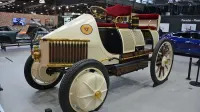Ferdinand Porsche’s first hybrid could have revolutionized the car

PARIS — Porsche earned its enviable reputation by making cars powered by a flat-six engine, not by peddling hybrids, yet company founder Ferdinand Porsche dabbled in gasoline-electric technology well before he created the company that bears his name. The firm traveled to Retromobile 2020 in Paris to display a replica of an early hybrid.
The project began around the turn of the 20th century when Lohner, an Austrian firm that’s part of Canada’s Bombardier group in 2020, reached out to Porsche to begin jointly developing an electric car. Some were sold and used in cities, but they were extremely heavy and they couldn’t drive very far on a single charge.
Rather than throwing in the towel, the two partners created an innovative gasoline-electric hybrid powertrain built around a pair of generators driven by two individual, 3.5-horsepower single-cylinder engines purchased from France’s De Dion-Bouton, a name that comes up often when researching the origins of the automobile. Electricity traveled through a lead battery to reach a pair of hub motors integrated into the front wheels. It was a complicated, relatively primitive, and highly unusual setup but it worked — pardon the pun — shockingly well.
Electric cars were smoother and easier to drive than gasoline-powered models at the time, so the motorists who got the opportunity to drive a Lohner-Porsche loved it. It could seat four, though the rear passengers were likely not as enthralled by the experience because they sat less than a foot away from the two uncovered engines.
Precise dates and production figures are largely lost to history. Porsche claims the hybrid — which was sometimes called Mixte-Wagen — made its debut in 1901, while some historians believe it didn’t appear until 1902. Production numbers are similarly vague, but what’s certain is that the model wasn’t a one-off. Approximately 300 units were made, an impressive figure considering Lohner’s hybrid cost much more than a comparable gasoline-powered car, and there was no such thing as an HOV lane in the early 1900s. Federal tax credits? No way in Hell (the Bavarian valley, of course).
If developed a little bit further, this technology could have matured in time to revolutionize the car as we know it today; imagine if, say, Renault, Ford, and Fiat had all entered the hybrid segment in the 1910s. However, Porsche — the engineer — and Lohner ended their collaboration in 1906 after a disagreement over patent rights. Porsche — the automaker — largely stayed quiet about this short-lived period in its ingenious founder’s early life until it prepared to release its first series-produced gasoline-electric model, the Cayenne S Hybrid, in 2010.
Related Video:




